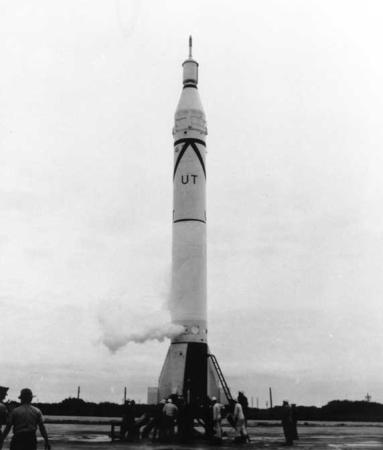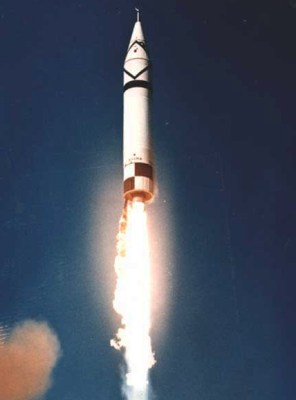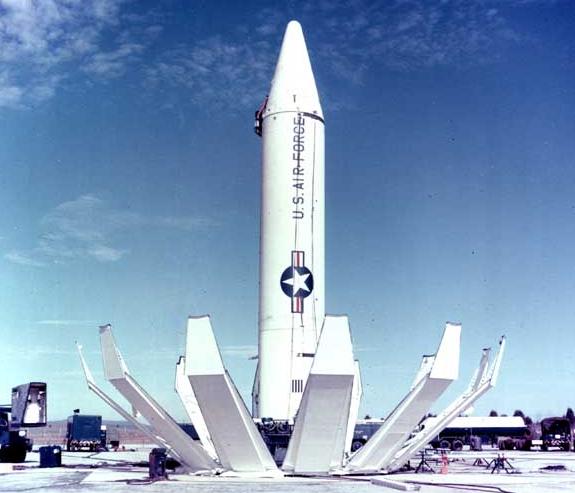Chrysler SM-78/PGM-19 Jupiter
The Jupiter Intermediate Range Ballistic Missile (IRBM) was originally developed by the U.S. Army as a long-range successor to its PGM-11 Redstone missile, but was eventually taken over and deployed by the USAF for political reasons. It was also the only one of the United States' early stategic ballistic missiles with some mobility.
The Army's Redstone Arsenal started the Jupiter program in 1954 as a 1600 km (1000 mile) range development of the PGM-11 Redstone. When the SM-75/PGM-17 Thor IRBM development was approved in 1955, the Army was ordered to develop Jupiter in collaboration with the U.S. Navy as a sea-launched missile. However, a liquid-fueled rocket was incompatible with the Navy's ship-borne safety requirements, and therefore the Navy began development of a solid-fueled Jupiter derivative (called Jupiter S) in February 1956. The Jupiter S was soon cancelled, however, being replaced by the UGM-27 Polaris SLBM. Tests of the Jupiter's Rocketdyne S-3D engine had been underway since November 1955, and flight tests of Jupiter components on modified PGM-11 Redstone missiles, designated Jupiter A, began in March 1956. Also in 1956, Chrysler was awarded a contract for all future production of Jupiter missiles. The Jupiter C was a further modified Jupiter A to test the new ablative reentry nose cone of the forthcoming Jupiter IRBM. It was equipped with a cluster of small rockets around the nose cone working as a second stage. First flown in September 1956, the Jupiter C earned fame when its four-stage derivative, the Juno I, launched the first U.S. satellite (Explorer 1) into orbit on 1 February 1958.
 |
| Photo: U.S. Army |
| Jupiter C |
The Jupiter IRBM itself differed significantly from the Redstone and Jupiter A/C missiles. Stemming from the original Navy requirements to store it in submarines, it was much shorter and fatter, and used a gimballed rocket nozzle instead of fins for stability and control. Most important for the later operational career of the Jupiter was a decision by the Secretary of Defense in November 1956 to settle a dispute between the Army and the Air Force about the responsibility for surface-to-surface ballistic missiles. It was decided that the USAF would be given the sole control for all missiles with a range over 320 km (200 miles). From this moment, Jupiter was officially an Air Force program, and the USAF in turn assigned the designation SM-78 to the Jupiter IRBM. Although the range restriction for Army missiles was lifted less than a year later, the Jupiter remained with the USAF.
 |
| Photo: U.S. Army |
| SM-78 (PGM-19A) |
Development of the Jupiter was still continued by the Army, and in October 1957 the first successful XSM-78 launch occurred. The USAF was initially somewhat reluctant to accept a second IRBM besides its "own" SM-75/PGM-17 Thor, but this was changed in November 1957, when DOD officially announced to deploy both the Thor and Jupiter IRBMs. In 1959, the USA had finally negotiated with Italy and Turkey to base the Jupiter in these countries. The first SM-78 squadrons became fully operational in Italy and Turkey in June and November 1961, respectively. After a few months, control of the Jupiter squadrons was turned over to Italian/Turkish troops. In total, 30 missiles were deployed to Italy, and 15 to Turkey.
The SM-78 was a single-stage rocket, powered by a single Rocketdyne S-3D engine fueled by kerosene and liquid oxygen. This was the same engine as in the SM-75/PGM-17 Thor. However, the SM-78 was a more effective IRBM than the SM-75, because of its mobility. Although a Jupiter launch site was far from easy to move, requiring more than 20 vehicles, it did significantly increase the missile's survivability in a pre-emptive attack, because the location of the Jupiters could not be pre-targeted by the enemy. Also, the SM-78's ablative reentry vehicle flew through the atmosphere at much higher speed than the SM-75's Mk.2 RV, making it less susceptible to wind drift and therefore significantly more accurate. The Jupiter's guidance unit was an ST-90 all-inertial navigation system by Ford Instrument.
 |
| Photo: USAF |
| SM-78 (PGM-19A) |
The SM-78 did not stay in service very long. In January 1963 the USA announced to withdraw all Jupiters from Italy and Turkey, and by July that year, the last missile had been removed. The U.S. Navy's deployment of the UGM-27A Polaris SLBM (Submarine-Launched Ballistic Missile) had made land-based IRBMs redundant. In June 1963, immediately prior to retirement, the SM-78 had been redesignated as PGM-19A. Until 1960, when production ceased, about 100 Jupiter IRBMs had been built by Chrysler.
Unlike many other retired USAF ballistic missiles, the SM-78 was not used as a space launch vehicle. The Jupiter formed the first stage of NASA's Juno II launch vehicle, but this was only moderately successful.
Specifications
Note: Data given by several sources show slight variations. Figures given below may therefore be inaccurate!
Data for PGM-19A:
| Length | 18.3 m (60 ft) |
| Diameter | 2.67 m (8 ft 9 in) |
| Weight | 49800 kg (110000 lb) |
| Speed | 16100 km/h (10000 mph) |
| Ceiling | 610 km (380 miles) |
| Range | 2980 km (1850 miles) |
| Propulsion | Rocketdyne LR79-NA (Model S-3D); 666 kN (150000 lb) |
| Warhead | W-49 thermonuclear (1.45 MT) in a Goodyear RV |
Main Sources
[1] James N. Gibson: "Nuclear Weapons of the United States", Schiffer Publishing Ltd, 1996
[2] Bill Gunston: "The Illustrated Encyclopedia of Rockets and Missiles", Salamander Books Ltd, 1979
[3] Redstone Arsenal Historical Information Website
Back to Current Designations Of U.S. Unmanned Military Aerospace Vehicles
Back to Directory of U.S. Military Rockets and Missiles
Last Updated: 22 January 2002